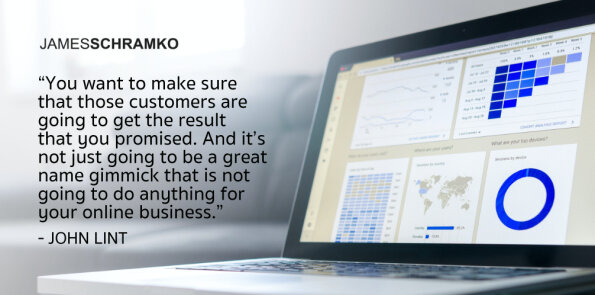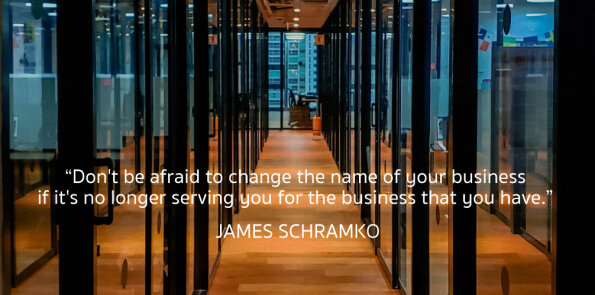Podcast: Download (Duration: 21:05 — 23.1MB)
Get Notified Of Future Episodes Apple Podcasts | Spotify | Amazon Music | Android | Blubrry | Gaana | TuneIn | Deezer | Anghami | RSS | More
James Schramko and John Lint have both fairly recently changed their company names.
They’ve met up here to discuss why changing your business name might be a good idea.
They talk about considerations in choosing a business name.
And John shares some technical tips around making the switch.
Table of contents
1. Before 10XPRO became Kleq
2. How important is the name when you’re new?
3. What evolution does to a name
4. When someone else is using your name…
5. The results of rebranding
6. Technical aspects of business name change
Before 10XPRO became KLEQ
John’s business started out as a tech solution for his own needs – one that could quickly build pages and create funnels. From there, it evolved into an all-in-one platform that could create and sell courses, deploy funnels, make pages, accept payments, and do automation and segmentation.
The software became accessible to other people, and was named 10XPRO, because it could take businesses to the next level, fast.
Years and many features later, John has renamed it Kleq.com. It’s more brandable, he feels, more modern, and will hopefully allow them to expand their market to a wider audience.
How important is the name when you’re new?
That’s a very desirable domain, says James. Would John have paid for a domain like that when starting his business, or is that something for later on?
John doesn’t think it matters in the beginning, unless you’re doing a hyped-up corporate thing where you need a good brand for the advertising.
What matters, he thinks, especially for software, is that you have a product that works, and that people enjoy and benefit from.
And of course, you want to make sure that those customers are going to get the result that you promised. And it’s not just going to be a great name gimmick that is not going to do anything for your online business.
So start with a name you like, something decent that at least matches the promise of your product. And then later on, if you want to expand your market, you can review and maybe pick a better name, and rebrand.
What evolution does to a name
There are always new entrants to the software space, says James, many with cool names and promotion by big time, trendy marketers. What they’re missing, however, is a depth and quality of the service.
That’s where John’s product is different. It started as a bootstrapped project, something to let him do things 10 times easier and 10 times faster – he’s moved past that.
John’s brainchild has become a quality product that does what he needs it to do and does it well, with great support to boot. And Kleq is an aptly more grown-up, more mature name for it.
In James’s case, when he started, he wanted to do things quickly – hence, SuperFastBusiness. He’s slown down since then, and has learned to focus on just the right things, realizing that good business is about sustainability and quality and a high level of service.
His brand grew up; John’s brand grew up. And so the names changed.
When someone else is using your name…
James recalls when his brand was trademarked only in Australia and the US. A big UK company, British Telecom, set up a division called SuperFastBusiness, with a co.uk website, workshops, and a YouTube channel.
That naturally caused some brand confusion when James would speak or meet clients in London. Confusion which he’s glad to do without, now.
He knows some people have built a big brand off 10X – he’s seen 10X conference and 10X on airplanes. He doesn’t know if John feels like he does, like he’d like his own lane, but he thinks it’s nice for John to not have the that old brand versus the new.
The results of rebranding
James thinks the rename to Kleq is a winning move, and he just has a couple of questions – one, was it technically difficult to change? And two, has John seen any positive or negative results since changing?
As far as results, John’s gotten great feedback from people – easier to remember, easier to use; traffic has picked up. He’s overall very happy with the outcome.
For James too, the response was quite positive. They had an instant boost in podcast downloads, and clients were very excited about it.
James did a post explaining why they changed the name, something he recommends people do. Communicate the change – what caused it, why are you changing the name of your business, and what is it now?
Where it can go wrong is if you change to a name and have to change back shortly after. If done quickly enough, it may not be the end of the world, but to prevent that, James recommends getting a trademark, and checking that the name hasn’t any negative meanings or connotations in other languages.
Technical aspects of business name change
In terms of the technical, John will say you do need to work with someone who is technically oriented.
You don’t have to do it yourself
You do not have to be technical yourself. You can hire someone from Fiverr or Upwork, and it won’t cost you a fortune.
John himself had to ask his developer, How do we do that? How do we do a find-and-replace? And the developer did it for them.
If you’re thinking ahead…
If you’re thinking of changing your business name in the future, a few cautionary tips will save you headaches. One is, do not have any file names containing your existing brand.
That is a problem, because if you do a query that says, if you find the old brand name, change it to the new one, that query might also change it in the file names of video, and that will break the videos.
There’s an order of difficulty in changing data, says John:
Text
The easiest is text material. If it’s a text entry in your database, it’s super easy to change with a simple query.
Say you’ve got your old name on several web pages. You can run a query which will replace every single instance of the old name with the new one – easy.
Images
Next in difficulty is images. Ideally, if you can, don’t put your brand name on an image, if you don’t really have to. Of course, your logo, you’ll likely have to.
Videos
The most difficult level is video.
If you’re mentioning your brand every two seconds, that is a problem that can only be solved by reshooting the video. Or you can have a message on your page indicating it was recorded when the business name was so and so.
Preserving SEO rankings and URLs
Now a question John gets all the time has to do with preserving SEO rankings and URLs.
James, for instance, had his podcast for a long time. He had a lot of links coming to him using the old domain name, and he would want to keep those valid.
Say a page URL used to be superfastbusiness.com/john, and James now wants people to land on JamesSchramko.com/john. It would seem like a nightmare to work around, but it’s actually easy.
You can even use a free tool like cloud flare.com, says John, specifically Page Rules in Cloudflare. If you don’t know how to do it, ask someone technical – the guys at Kleq had it done in two seconds.
Page Rules is basically a rule that says, if they try to go to the old domain name, and they put anything else after the domain name, they’ll be redirected to the current URL with a 301 redirect, which is a Google-friendly redirect. This SEO-preserving redirect tells Google to update their stuff with the new domain name.
The biggest takeaway
James’s old forum was FastWebFormula, which became SuperFastBusiness, and now is James Schramko. The exact same posts have lived over three domains.
John is similarly on his third domain since 2009.
The main point of the episode is, don’t be afraid to change the name of your business if it’s no longer serving you for the business that you have.
There will be some difficult decisions. James left his old YouTube channel and his old Instagram – he just forgot about them and started again, on his personal brand.
There are some things you can’t just change the name on, but there’s a lot of things you can. John just recently changed the website and the whole brand for a Kleq client, in a couple of hours.
As soon as you realize you have to change names, get onto it – the sooner, the better. And as James and John have both experienced, it’s worth protecting yourself with a trademark, if you can afford it.
If you’ve got questions about changing your domain name or your website, flick James an email or post a comment here, and he’ll be happy to raise it on a future episode.
Enjoy the world-class support and the company of other thriving business owners inside the James Schramko membership
Enjoyed the show? Leave us a review on iTunes













Leave a Reply